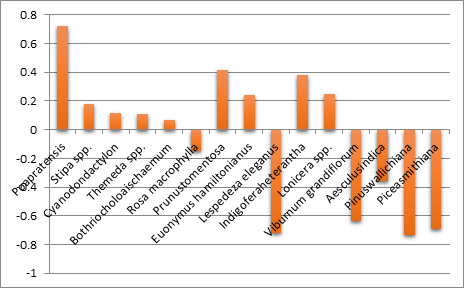


Indian Journal of Science and Technology
Year: 2020, Volume: 13, Issue: 24, Pages: 2463-2474
Original Article
Mehraj Bashir1, Mustahson F Fazili1, Fayaz Ahmad1, Jahangir Ahmad1*
1Department of Zoology, University of Kashmir, Srinagar, 190006, Kashmir, J&K, India
*Corresponding author
Email: [email protected]
Received Date:28 April 2020, Accepted Date:09 June 2020, Published Date:09 July 2020
Background/Objective: Understanding winter diet composition of wild ungulates in temperate habitats is of paramount importance for devising conservation measures. The winter diet composition of Markhor (Capra falconeri), one of the least studied ungulate species, was assessed in Kazinag National Park (KNP) of Jammu and Kashmir, India. Methods: Reference slides of 15 available plant species, through micro-histological technique were prepared. Tests like Diet Selection Values (DSV), Ivlev's Electivity Index (IEI) and Chi-square tests were applied to study the selection and preference of dietary items. Findings: 80 fecal samples of markhor were analyzed in winter seasons of 2017 & 2018, and compared with reference slides to evaluate the winter diet. Fifteen (15) plant species belonging to 7 families were identified in the diet. Use of Ivlev's Electivity Index (IEI), revealed that, shrubs were strongly preferred during this season, besides one graminoid species (Poa pratensis). Among the most preferred species are, Poa pratensis (DSV=6.17) followed by Prunus tomentosa (DSV=2.42), Indigofera heterantha (DSV=2.23), Lonicera spp. (DSV=1.66) and Euonymus hamiltonianus (DSV=1.63). Chi-square goodness of fit test showed that markhor did not feed on all plant species uniformly (p< 0.05). Novelty: Our findings infer that, markhor shows feeding flexibility to adapt to change in forage availability. We recommend that plant species which are the major components of diet of markhor during resource- lean winter be conserved and propagated on priority.
Keywords: Diet composition; fecal analysis; Kazinag National Park; markhor; winter
© 2020 Bashir, Fazili, Ahmad, Ahmad. This is an open-access article distributed under the terms of the Creative Commons Attribution License, which permits unrestricted use, distribution, and reproduction in any medium, provided the original author and source are credited. Published By Indian Society for Education and Environment (iSee)
Subscribe now for latest articles and news.